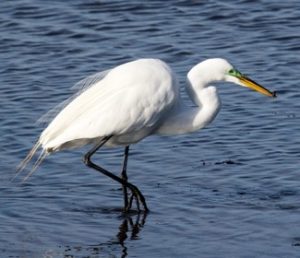By Jessica Baez and Christine Thompson
You’ve seen oysters in raw bars at the shore, but you may not have realized they were once part of a bustling ecosystem in the Barnegat Bay! A combination of years of pollution, development, overfishing, and diseases have reduced oyster populations drastically in the bay. That’s unfortunate, since oysters can filter up to 50 gallons of bay water a day and create three-dimensional habitat for fish and other invertebrates, similar to how coral reef ecosystems increase diversity in the tropics. The growing popularity of oysters at seafood restaurants have led to a surge in awareness of their ecosystem benefits and interest in rebuilding their populations.
Thanks to a grant from the Barnegat Bay Partnership, two oyster reefs are being restored and studied in the Barnegat Bay. A small-scale project, led by Stockton University and the American Littoral Society, took place over the course of the past two years at two locations: Good Luck Point, in the upper portion of the bay with a lower salinity, and Little Egg Harbor (Tuckerton), in the south at a higher salinity.
The project used two oyster-seeding methods. One method used oysters that were remotely set in shore-based tanks using a selectively bred disease-resistant strain from Rutgers Aquaculture Innovation Center. The pathogen causing the oyster disease, or Dermo, came to New Jersey in the 1990s. Dermo is detrimental to native oyster populations and thrives in higher salinities that oysters may experience in the Barnegat Bay. The second method transplanted oyster seed from natural beds located in the Mullica River to the south of the Barnegat Bay. These natural oysters had no selective disease resistance, but instead were a genetically variable natural stock.
After planting, oysters were assessed as to how they would survive, grow, and support the complex bottom communities that find refuge within an oyster reef’s nooks and crannies. These assessments help researchers understand the most successful methods for restoration and the different communities that can be created with each type of reef in different locations.
Results of the first year of monitoring showed the natural transplants had similar survival and growth when grown side-by-side with the planted disease-resistant strain. By the second year, however, 90-95% of the largest oysters from the transplanted seed showed high levels of Dermo infections, while only 5-10% of the disease-resistant oysters were infected.

Restoring reefs with disease-resistant populations would not only help oysters overcome these diseases, but also enhance the bay through the added ecological and economic benefits they provide. These benefits include water filtration, natural coastline resilience from erosion, protection from storm wave energy, and revenue for our coastal economy. Not only could the oysters be harvested, but coastal managers can grow these three-dimensional reefs to draw in commercially and recreationally important species that are reef-associated.
Dr. Christine Thompson’s Shellfish Ecology and Restoration Lab at Stockton University is continuing to monitor the ecosystem services and community interactions from these reefs. Follow-up studies include recording which types of fish and crabs are using the reef, assessing predation and other harmful interactions caused by the oyster drill snail and boring sponges, looking for signs that oysters are reproducing, and measuring how oysters contribute to water quality and nutrient cycling in the bay. Additionally, community partners such as Jenkinson’s Aquarium and Jetty Rock Foundation have picked up on this trend and are providing support for continued additions of oysters to the reefs.
The hope is to one day expand this small-scale endeavor into a large-scale venture, but that means securing the necessary funding and infrastructure to go big. While both reef-building methods had pros and cons, the disease-resistant oysters had higher maximum growth, showed advanced disease-resistance in the bay, grew vertically in the water column providing complex habitat, harbored more diversity, and had oyster settlement during both study years. The catch for this method? The disease-resistant line comes with a higher price tag.



